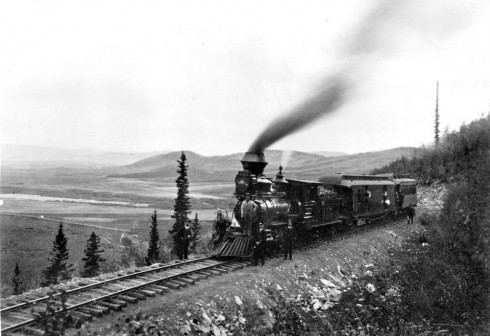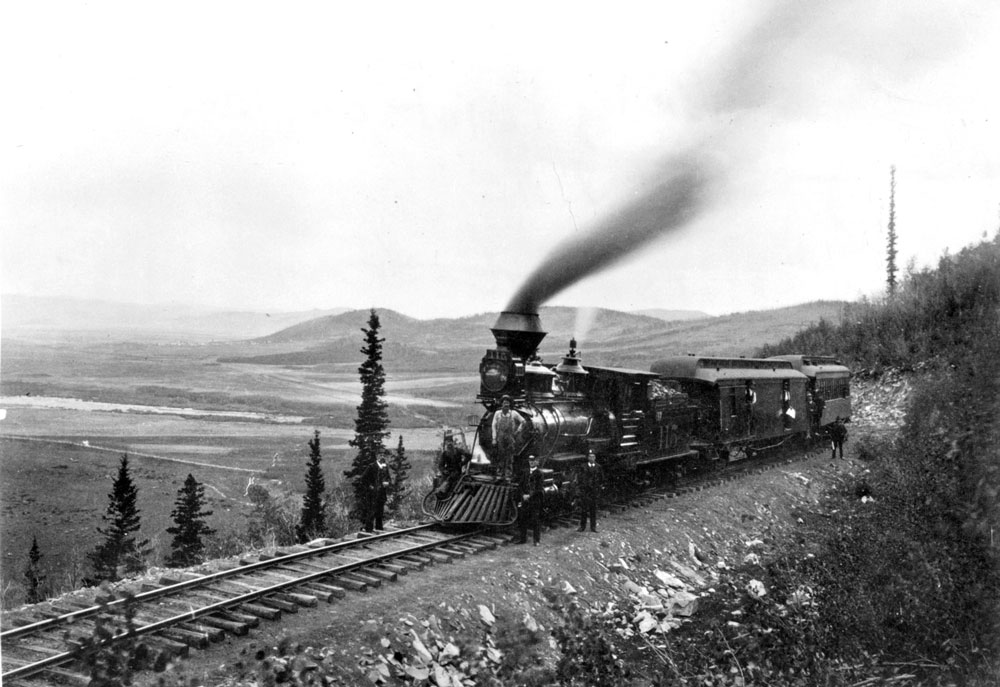By Virginia McConnell Simmons
Only a few ghostly vestiges of the Denver, South Park and Pacific Railroad remind us today of challenges that once played a role in the daily life of Central Colorado. This legendary narrow-gauge line, sometimes called “The Damn Slow Pulling and Pretty Rough Riding,” battled blizzards, floods, rockslides, derailments, corporate competition, and, far from least, human courage and hardship. Trains ran summer and winter on rails that crossed the Continental Divide in three places, burrowing through Alpine Tunnel (11,523 el.) to Gunnison County, and topping Boreas Pass (11,482 el.) and Fremont Pass (11,318 el.) to the Blue River and Leadville.

After former Governor John Evans and others incorporated the DSP&P in 1872, economic conditions delayed construction until 1878, when tracks at last headed from Denver to Platte Canyon in a race to reach the booming mines in the mountains. Rails crossed Kenosha Pass to Jefferson in South Park in 1879, but when the line descended Trout Creek in 1880 to the Upper Arkansas River, the die had already been cast. The all-important traffic to Leadville had been promised to the Denver and Rio Grande Railroad, due to Jay Gould’s manipulations.
The corporate story of the line reflected the vagaries of both railroading and mining. The Denver, South Park & Pacific Railroad, which was tied corporately to the Union Pacific system, became the Denver, Leadville & Gunnison Railroad following the DSP&P’s foreclosure in 1889. (Thus, the DL&G name appears on the depot that has been moved to a park in Buena Vista and restored.) After the UP went bankrupt in 1893, the Colorado and Southern Railway acquired the DL&G along with some other railroads in Colorado, and, in time, the C&S became part of the Chicago, Burlington & Quincy system (CB&Q).
Early on, the little railroad became known popularly as the “South Park.” Its division headquarters were in South Park at Como, where it had a large stone roundhouse (some of it still standing), a turntable, coal docks, a station in a two-story hotel with a dining room (still standing). The gritty, windswept town was home to many employees, trainmen, shop workers and their families, who were never certain when the crew would return for a hot meal and a few hours of rest before being called for another run. The regular schedule of passenger trains, one daily to and from Denver, was often delayed if the little locomotives could not buck their way through snowdrifts and had to wait for a rotary plow to tackle them.
The DSP&P had not lost sight of its western goal. But along the way, when the “South Park” was constructed toward Trout Creek, the line, which circumvented Red Hill, constructed the Alma Branch from Garo to Fairplay, Alma, and the mining districts and short lines around the Mosquito Range. From 1881 until the late 1930s, a daily mixed train would connect from Garo to Alma.
Hundreds of workers were already digging the Alpine Tunnel in the winter of 1880-1881, though. The route from Nathrop in the Upper Arkansas River Valley lay up Chalk Creek and down Quartz Creek to Pitkin and Gunnison, and a great palisade of stone and redwood shoring were required on the west side of the Divide. Alas, the D&RG was on its way over Marshall Pass and reached Gunnison two years ahead of the DSP&P. The westernmost point for the DSP&P was the coal mines at Baldwin and Kubler near Gunnison, with some livestock and hay transport adding seasonal revenue.
The notorious Alpine Tunnel plagued the line with cave-ins, smoke, and the death of an engineer from carbon monoxide, and an avalanche on the west side crushed the Woodside Station and killed 13 people, including six children in one family. The tunnel was closed intermittently, then permanently after 1910.
Mining in Chalk Creek had created excitement around St. Elmo, Romley, and Hancock in the 1870s before trains arrived, but no great bonanza justified the railroad’s costs for construction and operations. When mining hit the doldrums in the early 1900s, freights continued to run from Buena Vista to Romley, mainly to serve the Mary Murphy Mine. By 1923 the tracks up Chalk Creek were removed. The Chalk Creek area has remained popular with tourists, though, and a trek on the old grade to the tunnel is a favorite destination of rail buffs.
Principally, from 1881 until 1937, the railroad traffic of the “South Park” was over the High Line on Boreas Pass, aptly named for the North Wind. While the Alpine Tunnel was still being dug, the determined railroad headed for Leadville from Como by way of the High Line. Except during delays caused by snow and derailments, trains arrived daily at Boreas Pass, where there were snow sheds, a telegraph station, a section house, a turntable, and the Baker Tank. High-country visitors today find a historic district on Boreas Pass, and the Baker Tank has been restored.
From the Boreas Pass summit to Breckenridge frequent derailments and tragic death occurred. The High Line descended at five mph down a harrowing 11 miles, testing the nerves and skill of engineers on the trip down, and the stamina of firemen of the trip up. From the mining country along the Blue River, the High Line ran to Dillon, Frisco, Kokomo, Robinson, Fremont Pass, and finally Leadville. When mining fell off, the “South Park” attempted to abandon the High Line, but protests at Breckenridge resulted in court action and continuance of the line with a daily mixed train between Denver and Leadville. In 1937, during the Great Depression, the High Line was at last abandoned, and tracks were removed the following year, sounding the death knell for Como, too.
During World War II, in 1943 the C&S standard-gauged the line from Leadville to the important molybdenum mine at Climax, and trains ran to it until 1962. The Leadville, Colorado & Southern Railway now operates excursions during the summer season from the old DSP&P depot on East Seventh Street, a reminder of a past era.
Virginia McConnell Simmons is the author of Bayou Salado and several other books about this region.



